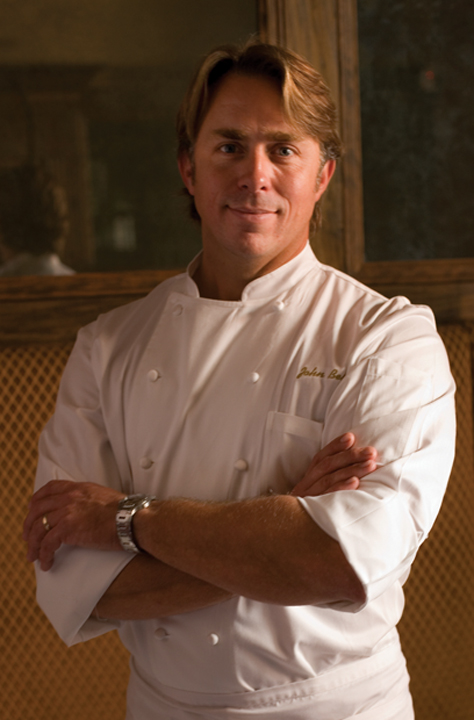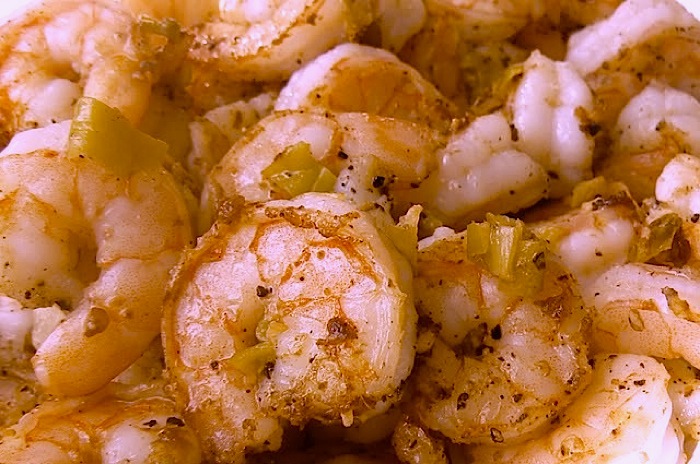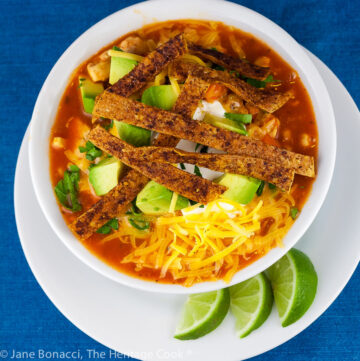One of the highlights of my trip to Austin was having the chance to watch Chef John Besh doing a live cooking demo. What a fun, charming man he is! Having worked in various cooking schools, I am accustomed to prepping all the ingredients for visiting chefs and dealing with some challenging personalities occasionally. But Chef Besh prefers to do all the prep himself. So there he was, in front of a standing-room-only crowd, chopping the onions by himself! It was such a treat to see someone so completely at ease in front of an audience.
Chef Besh is a native of southern Louisiana and one of its favorite sons. He currently has six acclaimed restaurants (August, Besh Steak, Luke, La Provence, American Sector, and Domenica) which celebrate the culinary richness of the region. He attended the Culinary Institute of America and was named on of Food and Wine’s Top 10 Best New Chefs in America in 1999. In 2006 he won the prestigious James Beard Award for Best Chef of the Southeast.
A former Marine (he served in Operation Desert Storm) and father of four sons, Chef Besh is a delightful surprise. You wouldn’t expect someone with his background and easy-going personality to be an internationally renowned superstar in the culinary world. He seems more like an old college buddy or someone’s favorite cousin just hanging out and shooting the breeze. But beneath that relaxed demeanor is a deep passion for the heritage and people of the Gulf Coast.

Chef John Besh
After Hurricane Katrina, Besh’s Restaurant August was one of the first restaurants to reopen, and was strongly involved in efforts to help the victims in the area. He set up his kitchen to help feed the refugees, evacuees, medical and law enforcement personnel until they could reclaim some sense of normalcy. In the wake of the Gulf Coast oil spill, he once again rolled up his sleeves and spoke on behalf of the fishing industry, urging people to eat U.S. seafood and “save a way of life.”
John Besh is a force to be reckoned with. He can often be seen cooking for the morning new programs, charming Martha Stewart and Paula Deen, or competing on Top Chef Masters and The Next Iron Chef. His cookbook, “My New Orleans” has 200 recipes and is the story of how he grew up eating. His childhood in Slidell, Louisiana, cooking for his disabled father, and fishing in the local rivers left indelible imprints. He combines that history with his training in French cuisine and techniques to create his unique style of cooking.

Raw Shrimp
Today’s recipe, Shrimp Creole, is a New Orleans classic dish, and one that brings back wonderful memories for me. I have been lucky to visit New Orleans on a couple of occasions and would happily return anytime – The Big Easy is easy to love!
When I think of “Food” cities of the world, New Orleans is in my Top 10. Full of atmosphere, incredible restaurants, and some of the nicest people, every time I return, it is like coming home. Even after multiple natural disasters, New Orleans has maintained its graciousness and culinary prowess. I am proud to share its heritage and amazing cuisine with you.

Cooked Shrimp
Creole-style dishes are similar to gumbo and jambalaya, with the rice being cooked separately and often used as a bed for the delicious stews and sauces. Spicy and rich with a multitude of flavors, Shrimp Creole is a mixture of French, African, and Spanish influences. With the ever-present Holy Trinity of onions, celery, and bell peppers, you add shrimp, tomatoes, garlic, and seasonings to create a richly satisfying dish. It is remarkable how much flavor can be developed in such a short time.
Showing his flair for unusual pairings, Chef Besh uses lemongrass, a typical Asian seasoning to give you a “what in the heck is that” flavor. The surprising addition of basil and mint continue to tantalize your taste buds. I know that you will fall in love with Shrimp Creole all over again, or maybe for the first time, when you taste this fantastic version. Run out right now and get the ingredients because you are not going to want to wait another minute to try it!

Lemongrass
Jane’s Tips and Hints:
You can buy frozen pre-cleaned and peeled shrimp at stores like Whole Foods and Trader Joes. These are terrific options when time is short and you need to get dinner on the table quickly. I like to keep a bag in my freezer to use in salads, with pasta, and in dishes like today’s Shrimp Creole.
Kitchen Skill: How to Peel and Devein Shrimp
Peeling shrimp is actually quite easy. Remove the legs and slip your thumb under the shell, pulling it back and twisting it off. Save the shells to make a delicious stock!
Once the shrimp are peeled, you want to devein them, which is removing the vein that runs down the back of each one. It is the intestinal tract and can give your food off-flavors if left in.
Using a very sharp paring knife, make a clean slice down the back of the shrimp (the outside rounded edge.) Hold the shrimp under running water and remove the dark vein. Drain the cleaned shrimp well before cooking.


- Rice
- 2 tbsp chicken fat, organic extra-virgin olive oil, or butter
- 1 large onion, minced
- 3 cups Louisiana long-grain white rice
- 6 cups chicken stock
- 1 to 2 bay leaves (1 if it is large, 2 if they are small)
- 3 pinches of salt
- Shrimp
- 5 lb jumbo Louisiana or wild American shrimp, peeled and deveined
- Salt
- Freshly ground black pepper
- 1 tbsp minced fresh lemongrass
- 1/2 cup organic olive oil, divided
- Sauce
- 3 medium onions, peeled and diced
- 10 cloves garlic, peeled and thinly sliced
- 1 stalk celery, diced
- 1 bell pepper (red, green, or yellow) seeded and diced
- 5 lb overripe Brandywine or other heirloom tomatoes, peeled, seeded, and chopped (you can use canned tomatoes if fresh tomatoes are not available)
- 1 bay leaf
- 1/4 tsp allspice
- 1 tbsp crushed red pepper flakes
- Leaves from 2 branches of fresh basil, chopped
- Leaves from 1 sprig of fresh mint, chopped
- Sugar, if needed
- For the Rice: Put the fat, oil, or butter and the onions into a medium saucepan and sweat the onions over moderate heat until they are translucent, about 5 minutes. Pour the rice into the pan and stir for 2 minutes. Then add the chicken stock and bring to a boil. Add the bay leaf and the salt.
- Cover the pan with a lid, reduce the heat to low, and cook for 18 minutes. Remove the pan from the heat; fluff the rice with a fork, and reserve.
- For the Shrimp: Place the cleaned shrimp in a large bowl, season with salt and pepper, and then mix in the lemongrass. Heat 1/4 cup of the oil in a very large, deep skillet over moderate heat. Add the shrimp, stirring and tossing them with a spatula. Saute until they turn pink, about 2 minutes. Remove the shrimp from the pan and set aside while you make the sauce.
- For the Sauce: Into the same skillet with the oil and shrimp juices, put the remaining 1/4 cup oil and the onions, garlic, celery, and bell peppers and cook, stirring constantly with a wooden spoon, for about 2 minutes.
- Add the tomatoes. Reduce the heat to medium-low and when the sauce comes to a simmer add the bay leaf, allspice, and red pepper flakes. Simmer for 10 minutes.
- To Assemble: Add the shrimp back to the skillet along with the basil and mint. Cook for a minute or two. Season with salt and pepper. Taste and if the sauce tastes too tart, add a little sugar to balance the flavor. Remove the bay leaf. Serve over steamed Louisiana white rice.
- Yield: 12 to 15 servings
Thank You!
Lousi







Y-SpaceAlien PlanetDooF
A few years ago, some Earth friends and I worked with kids in New Orleans, helping them to preserve the family recipes they’d lost (often, along with everything else) after Hurricane Katrina. Chef John Besh cooked with the kids, making his family recipe for cornbread in his granddaddy’s 150-year-old cast-iron skillet. The combination of recipe and memory made it the best cornbread ever! A favorite cast-iron pan is seasoned with time and love — and the wonderful things that come out of that pan can make people happy for generations. Recipes are the same way: they can take you back to another time — and give you a taste of days gone-by. Thanks your wonderful Austin post, Jane (BTW, I was at John’s presentation too, zooming up to the stage to get a taste of his signature creole: it’s truly amazing. Just like your writing!)
Jane Bonacci, The Heritage Cook
Laura, what a wonderful experience that must have been, I would have loved to be there too. I agree, recipes can be the foundations for memories that last a lifetime! I have my grandmother’s cast iron skillets that she used to feed us with all the love in her heart. Thank you for sharing this special memory with us (and your very kind words)!
Katrina
What a great part of your trip. I love “meeting” or hearing from great chefs! He was always my favorite in Next Iron Chef. Great post!
Jane Bonacci, The Heritage Cook
Thank you Katrina! If you ever have the chance, eat at one of his restaurants. You won’t regret it!